Chapter 2
The Era of the Giants
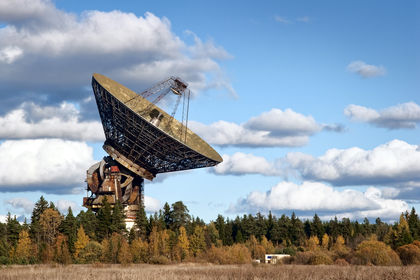
During the later part of the eighteenth century, while European astronomers debated the merits and deficiencies of both refracting and reflecting telescopes, the Englishman William Herschel recognized that regardless of the type of telescope, the larger the lens or mirror, the better the image created. Herschel's conclusion prompted a race among astronomers to build giant telescopes, a competition that continues to this day.
In 1774, at the relatively late age of thirty-five, Herschel abandoned the life of a professional musician to focus on constructing telescopes and observing the heavens. After making inquiries about purchasing a five- or six-foot-long reflector telescope, only to learn that no instrument that size had ever been built, Herschel sat down to cast and polish several nine-inch mirrors for a ten-foot-long Gregorian telescope of his own design. Herschel's sister Caroline, who shared Herschel's interests, wrote that on one occasion, "in order to finish a mirror, he had not taken his hands from it for sixteen hours." 5 Herschel's hard work had its reward. In 1776, he wrote in his journal that he had spent the night looking at "Saturn's ring and two belts in great perfection." 6 Herschel was delighted to boast that his instrument, more powerful than any previous telescope, achieved a magnification power of 240. Using such a telescope in March 1781, Herschel was the first to see the planet Uranus, the fifth known planet of the solar system, and to map and identify over two thousand star clusters and nebulae, which are large clouds of interstellar dust and gas created by cosmic explosions.
The First Observatory
In 1786, Herschel's quest to make more discoveries motivated him to buy a larger house and grounds to accommodate an unprecedented forty-four reflector telescope with a forty-eight-inch primary mirror. A telescope of this magnitude would exceed the weight and size of earlier models that could be manually tilted and rotated to peer into the night sky. Such a herculean task would now require a complex structure to support and aim an iron tube of several hundred pounds to house the primary and secondary mirrors. Herschel also needed to build a structure to house all of the instrumentation required to observe the heavens.
Herschel initially hired forty workmen to pour a concrete foundation on which the telescope and its supporting structure could rotate to any direction in the sky. Next he designed and supervised the construction of the wood frame for the observatory. Although he did not design a roof to protect the telescope from the elements, the observatory required a complex wood structure in the shape of a pyramid to support the telescope's weight. This sixty-foot-tall structure consisted of long primary beams supported by hundreds of diagonal braces to provide sturdy support. Attached to this system of beams and braces were ladders that led to a platform at the elevated end of the telescope where Herschel could make fine adjustments to the telescope and clean it when necessary.
On the interior floor of the observatory, where Herschel would sit and make his observations, he built a small cottage to protect him from the weather. He cut a hole in the roof of the cottage to accommodate
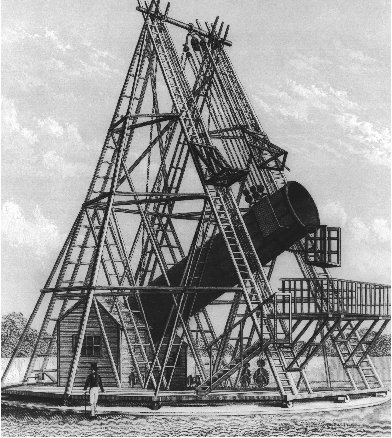
As an adjunct to the observatory, Herschel constructed work sheds where the telescope would be made and later repaired. In one, a crew forged the forty-foot-long iron tube that would house the mirrors. In a second, Herschel cast the world's largest mirror. To improve the quality of the mirror, he experimented with the composition of the metals to achieve more resistance to corrosion. He increased the concentration of copper and arsenic while slightly reducing the tin content. He also experimented with a thin coating of silver for greater reflectivity.
"The Greatest Observer Who Ever Lived"
All of Herschel's efforts paid off. Three years after beginning his observatory, while peering through his forty-eight-inch telescope, he discovered two more of Jupiter's moons, bringing the known total at that time to six. His observations of what had previously been considered indistinguishable globular clusters of light revealed distinct star clusters within the Milky Way. Looking at the constellation of Orion, Herschel expressed his satisfaction with the quality of his big mirror: "The object I viewed was the nebula in the belt of Orion, and I found the figure in the mirror, though far from perfect, better than I had expected. It showed the four small stars in the Nebula and many more. The Nebula was extremely bright." 7
In 1781 Herschel went on to identify Uranus, the first planet discovered since antiquity, prompting him to say, "I have looked further into space than any human being did before me." 8 During the early nineteenth century, while mapping the Milky Way, he was the first to demonstrate that the entire solar system moves through space. Accomplishing so many things with this one telescope prompted the modern astronomer Patrick Moore to comment, "William Herschel was the first man to give a reasonably correct picture of the shape of our star-system or galaxy; he was the best telescope-maker of his time, and possibly the greatest observer who ever lived." 9
Herschel's discoveries place him among the pantheon of modern astronomers. Yet, the problems with mirrors continued to plague the science of astronomy. Metals were difficult to grind and even more difficult to keep free of corrosion. Before astronomers would see farther into space and with greater resolution, a solution to these mirror problems was needed.
The First Glass Mirror
At the same time that Herschel was exploring the universe, glassmaking technology was improving. Dozens of household objects such as drinking glasses, flower vases, and elaborately decorated bowls were made using the latest glassblowing and molding techniques. One type in particular, decorative glass bowls with a silver interior film that reflected light onto the bowl's contents, caught the attention of astronomers.
About 1860, seizing on the process of making reflecting glass bowls, the French physicist Jean-Bernard-Léon Foucault achieved notable success when he manufactured a four-inch and then a twelve-inch glass telescope mirror with a silver surface capable of greater reflectivity than the finest polished metal. Since the mirror was made of glass, once it was ground and polished, it would be corrosion-free and would never require further polishing.
Within twenty years, silver-coated glass mirrors became standard throughout Europe. Glassmakers realized that they could heat molten glass, pour it into molds shaped for curved mirrors, impress the initial curve onto the surface, and thereby reduce the amount of grinding. And as glass manufacturing progressed, so did the silvering technique. By 1880 a fifteen-inch glass mirror achieved a 1,200 magnification power, far superior to Herschel's forty-eight-inch metallic mirror. The discovery of the glass mirror was the missing link needed for larger reflecting telescopes, and it sounded the death knell for refracting telescopes.
The Mt. Wilson Sixty Inch
The twentieth century opened with the construction of the largest mirror yet conceived. Measuring sixty inches in diameter, with a thickness of eight inches, and weighing two thousand pounds, the mirror had
The First Astronomical Photograph
For three hundred years telescopes had been used to discover distant celestial bodies, but it was not until the late nineteenth century that they were first used to document their discoveries. On the night of September 30, 1880, American amateur astronomer Henry Draper obtained the first astronomical photograph—a picture of the Great Nebula of Orion.
Draper had experimented with the daguerreotype camera, the first camera invented, one of which he mounted to a telescope eyepiece. With a very slow shutter speed of 104 minutes, the image of the nebula was shot on an eleven-inch achromatic telescope. The resulting photographs were not very impressive, but Draper made further refinements by mounting better-quality cameras on the telescope's eyepiece and adjusting the exposure time.
Other photographic firsts for Draper include the first wide-angle photograph of a comet's tail and the first spectrum of a comet's head in 1881. In addition, Draper obtained many high-quality photographs of the moon, some of which he enlarged to five inches in diameter, a revolutionary improvement over smaller ones.
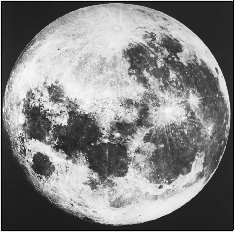
been cast fourteen years earlier by the Saint-Gobain glassworks in France. When completed, it was shipped to Pasadena, California, where the final shaping and polishing were done, and in 1908 the mirror was installed in an observatory atop Mt. Wilson.
The telescope was placed under the supervision of lead astronomer George Ellery Hale, whose multimillionaire father had purchased the mirror for him for the then enormous price of $25,000. Hale's objective for the world's largest telescope was to see more distant objects with greater resolution than ever before.
Hale received accolades for building the sixty-inch telescope, but it was Edwin Hubble, director of the observatory, who gained recognition as one of America's most esteemed astronomers while using this instrument to make revolutionary discoveries about the nature of the Milky Way. Hubble and his colleague Harlow Shapley used the sixty-inch telescope to determine the position of the solar system within the galaxy. They were also the first to measure the size of the Milky Way, estimating it to be about ninety thousand light-years across (one light-year is the distance light travels in one year, roughly 5.9 trillion miles) and containing roughly 200 billion stars. They also determined that the galaxy is in the shape of a spiral, with a bulged central section and radial arms that start in the center and extend outward to form a flat pinwheel shape. They pinpointed the position of the solar system about two-thirds of the way out from the center of one of the arms, named the Orion Arm, and established the arm's thickness to be about three thousand light-years.
As astronomers looked deep into space, many trillions of miles, for the first time, they were astonished by the magnitude of the Milky Way and the vast distances between Earth and its newly discovered intergalactic neighbors. Hubble and Hale were two of several pioneering astronomers to recognize that when they studied distant stars, they were actually peering
George Ellery Hale
George Ellery Hale remains one of the giants of twentieth-century astronomy. He was born in Chicago in 1868, an only child and heir to his family's considerable fortune. Hale developed an interest in astronomy at a young age and benefited from the considerable financial support of his father, who purchased for him several sophisticated telescopes and spectrometers. At the age of twenty-three, Hale had his own private solar astronomical laboratory. By then he had graduated from the Massachusetts Institute of Technology and his scientific reputation was already well established.
Over the years Hale organized three world-class astronomical observatories. In the 1890s he secured funding for the University of Chicago's Yerkes Observatory, which housed the then-largest telescope in the world. Afterward he secured funds for the establishment of a solar observatory on Mt. Wilson in California, of which he became director in 1904 and which long remained the best solar observatory in the world, housing the world's largest telescope of its time. Though he did not live to see the project completed in 1948, Hale was the main force behind the construction of the two-hundred-inch telescope on Mt. Palomar in California. Later in life, suffering from recurrent episodes of depression, Hale resigned as director of the Mt. Wilson Observatory in 1923 and retired from active scientific research. On February 21, 1938, he died in Pasadena, California.
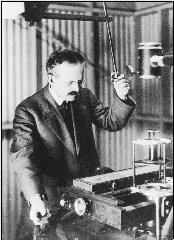
back in time to see the stars as they once were, not as they are in the present. This perplexing yet important phenomenon is known to astronomers as "look-back time."
A Look Back in Time
Light from distant stars travels at 186,000 miles per second, and according to the preeminent physicist Albert Einstein, nothing can exceed this speed. This speed limit means that even though light travels extremely fast, it still takes time to travel across the expansive universe. What early twentieth-century astronomers realized as they peered far into space was that the images they were looking at represented objects as they existed in the past, not as they exist in the present.
This perplexing phenomenon leads to the observation that telescopes actually look back in time. They tell astronomers, for example, how planets and stars 1 billion light-years away appeared 1 billion years ago, not as they appear today relative to Earth's time. In many cases, the stars photographed in deep space no longer exist, but astronomers won't know that until one day when they point their telescopes in the direction of a known star, only to discover it is no longer there. Thus, the seemingly simple question, "What is occurring right now on the cluster of stars called the Pleiades?" cannot be answered by an astronomer because it takes their light four hundred years to reach Earth. What astronomers see today when peering at this star cluster is how it existed when Lippershey and Galileo made their early contributions to astronomy.
The success of the sixty-inch telescope peering far back in time spurred scientists to build a much larger telescope capable of seeing even farther back. In 1917, while the sixty-inch telescope was making headlines, Hale and the Carnegie Institution planned to develop a telescope with an even larger mirror. They proposed and received funding for a one-hundred-inch telescope to be housed next to the sixty inch on Mt. Wilson. The new, larger telescope's mirror would be able to capture almost three times as much light as the sixty inch, making it far more effective for exploring the mysteries of the Milky Way and beyond.
Discovering the Expanding Universe
On July 1, 1917, the one-hundred-inch Hooker telescope arrived on Mt. Wilson with great fanfare. It was named in honor of John D. Hooker, a local businessman who provided the funds for the giant mirror in the largest telescope in the world at that time. Saint-Gobain glassworks fabricated the mirror from the same glass used for wine bottles. Holding the world's record as the largest solid plate glass mirror ever cast, the thirteen-inch-thick, nine-thousand-pound mirror
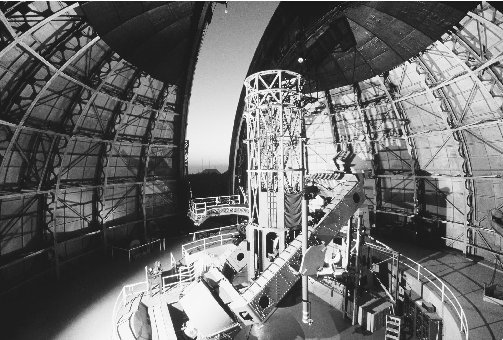
When the mirror arrived, engineers in charge of the final polishing were shocked to discover bubbles within the mirror that were created when the blank was poured. The Saint-Gobain facilities were the best in the world, but they did not have the means to melt and pour nine thousand pounds of glass in a single casting. Three pours were required, and that trapped air bubbles between each layer. The bubbles appeared as waves and swirls frozen in place, with some bubbles coming to within a fraction of an inch of the polished surface. Satisfied the surface was not diminished, engineers applied the final reflective coating as astronomers from around the world waited with great anticipation for new astronomical discoveries.
Their wait did not last long. Many astronomers consider that the Hooker telescope provided some of the greatest astronomical views and discoveries of the universe beyond the Milky Way. With this one-hundred-inch telescope, Edwin Hubble reported for the first time the distances and velocities of neighboring galaxies. This demonstrated that these galaxies are separate entities and not small nebulae contained within the Milky Way, as many astronomers had previously believed. Hubble also produced the most dazzling photographs of a seemingly infinite number of stars, spinning galaxies, and other mystifying phenomena that could not be viewed with the smaller sixty-inch mirror.
Hubble's greatest discovery would come in 1929 when he proved that the universe was expanding in all directions at a constant speed, a figure now referred to as "Hubble's constant." Knowing the rate of expansion, he was then able to estimate the age of the universe, placing it between 10 billion and 20 billion years. Combining these two findings meant that when the universe was much younger, it also had to have been much smaller. This conclusion eventually led to the theory, accepted by most astronomers today, that the universe was born at one instant in time in an explosion of energy called "the big bang." At that instant, the universe was a super-dense super-hot speck. Once the big bang occurred, the universe expanded from that point and has been expanding and cooling ever since.
By the end of the 1920s, astronomers were dazzled by the Mt. Wilson discoveries. They lobbied for even larger telescopes if such mind-bending discoveries were to continue. They pondered what might be discovered by building a monster telescope with a two-hundred-inch mirror, creating a reflective surface four times larger than the Hook mirror.
The Mt. Palomar Observatory
In 1930, Hale and the California Institute of Technology (Caltech) were awarded a grant of money by the Rockefeller Foundation to construct a two-hundred-inch telescope. Numerous locations were tested for the atmospheric conditions needed for optimum astronomical observing, and in 1934 Palomar Mountain, sixty miles northeast of San Diego, California, was selected. With part of his $6 million grant, Hale purchased 160 acres of land atop the mountain at an elevation of fifty-six hundred feet.
Finding the money and location for the world's largest telescope was the easy part. Fabricating the mirror would be the biggest headache because no one had ever attempted to create such a large mirror, and the larger the mirror, the greater the likelihood of casting failure.
Difficulties in Constructing the Big Eye
Hale approached the Corning Glass Works with a proposal to build the two-hundred-inch mirror, but after spending $1 million, optical engineers had achieved nothing but cracked blanks as the molten fused quartz glass cooled. Hale then recommended the use of a new
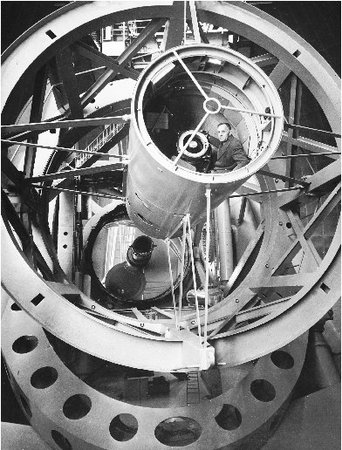
At the end of the fourteen-day trip, Caltech engineers ground the surface of the mirror to the approximate required concavity. Using successively finer polishing grit, the opticians then carefully smoothed the surface, constantly using optical tests to compare it with the desired curvature. When completed, the mirror had lost almost ten thousand pounds of glass. After thirteen years of grinding and polishing, interrupted by World War II, the "Big Eye," as it was named, achieved the desired form.
In 1948, the Big Eye, later named the Hale telescope in honor of its creator, captured "first light" by viewing and photographing distant objects only 1/40,000,000 as bright as the dimmest object visible to the naked eye. Capable of seeing objects billions of light-years more distant than the Hook telescope, the Hale's scope of work over the years was extraordinary.
Accomplishments of the Hale
Operating almost 365 nights a year, the Hale has been a workhorse. It was the first telescope to focus principally on celestial objects far beyond the Milky Way and the range of the one-hundred-inch Hook. Some of these objects that reside as far as 10 billion light-years from Earth, were originally thought to be stars. Hale clearly showed that they were actually "quasi-stellar objects," a term later abbreviated to quasars . Quasars are peculiar objects that radiate as much energy per second as a thousand or more galaxies, yet they have a diameter about one-millionth that of galaxy. Astronomers at Mt. Palomar were the first to suggest that quasars are associated with black holes and that they derive their awesome power from large quantities of gas pouring into a nearby black hole so rapidly that the energy output is a thousand times greater than the galaxy itself.
In the late 1950s, most of the evenings for the two-hundred-inch telescope were dedicated to exploring deep space in search of unusual, spectacular galaxies formed within 1 billion years of the big bang. The types of galaxies astronomers were looking for were those demonstrating some sort of cataclysmic event. The cataclysms are often the result of galaxies colliding, a phenomenon that chiefly occurred near the time of the big bang when celestial bodies had yet to fan out into the depths of space. Within a few years, several of these galaxies were located, and the resulting photographs depict massive gaseous explosions and halos of hot debris ejected into space.

In March 2004, the Hale made a discovery close to home, yet it was just as surprising to astronomers as their discoveries about distant quasars and colliding galaxies. Peering just 8 billion miles from Earth—the distance light travels in just twelve hours—astronomers were stunned to discover a small planet orbiting the sun. Named Sedna, this most recently discovered member of the solar system is three times more distant from the sun than Pluto. Astronomers are currently debating whether Sedna qualifies as the solar system's tenth planet or is simply a lowly planetoid.
For more than 350 years, since Lippershey and Galileo, astronomers steadily improved telescopes capable of capturing light from the most distant recesses of the universe. During that same period, physicists also discovered that there were other forms of light besides the light detectable by the eye. Eventually, some postulated, someone would figure out a way to detect light invisible to the eye.
Comment about this article, ask questions, or add new information about this topic: